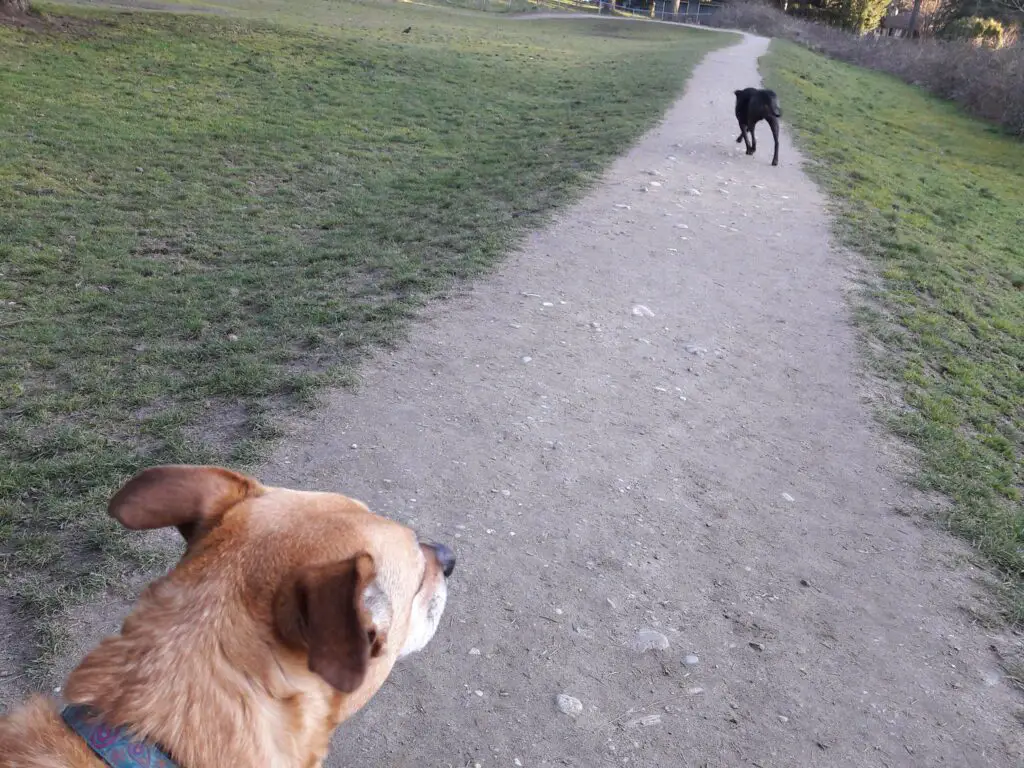As dog owners, we often find ourselves trying to understand and interpret our canine companions’ various behaviors.
One such behavior that may leave us puzzled is when a dog consistently blocks our path.
In this article, we will explore the different reasons behind this intriguing behavior, ranging from attention-seeking to anxiety or even instinctual drives.
- Why Does My Dog Block My Path?
- Is It Normal For Dogs To Block Your Path
- What To Do About Your Dog Getting in Your Way
- How Do You Know If Your Dog Is Trying To Dominate You
- Why Is My Dog Always In My Way?
- When Path-Blocking Behavior is a Sign of Anxiety in Dogs
- FAQs
- 1. What does it mean when my dog tries to block my path?
- 2. What are the most common reasons why my dog blocks my path?
- 3. Can my dog’s breed influence his tendency to block my path?
- 4. What command should I use to get my dog to move when he blocks my path?
- 5. Is it important to pay attention to my dog’s body language when he blocks my path?
- 6. How can I train my dog to stop blocking my path?
- In Conclusion
Why Does My Dog Block My Path?

Dogs may block your path due to attention-seeking, herding instincts, dominance, anxiety, resource guarding, or anticipation of routines and activities.
Reason 1: Seeking Attention
One of the primary reasons a dog may block your path is to gain your attention. Dogs are social animals, and they may resort to this behavior to interact with you or encourage you to engage in playtime or affection.
Reason 2: Herding Instinct
Some dog breeds have a strong herding instinct, which can cause them to attempt to control or direct your movements. By blocking your path, your dog may be exhibiting their natural herding behavior and trying to keep you within their perceived “safe” area.
Reason 3: Asserting Dominance
In some cases, a dog may block your path as a way of asserting dominance or establishing their position within the family hierarchy. This behavior can be a sign that your dog feels the need to assert control over their environment or other members of the household.
Reason 4: Anxiety or Insecurity
Dogs that experience anxiety or insecurity may block your path as a way to seek comfort and reassurance. This behavior can indicate that your dog is feeling uncertain or fearful and wants to stay close to you for safety and support.
Reason 5: Resource Guarding
If your dog is blocking your path while in the presence of a valuable resource, such as food, toys, or a favorite resting spot, they may be displaying resource-guarding behavior. This means they are trying to protect what they perceive as theirs from being taken away or accessed by others.
Reason 6: Anticipation of Routine or Activity
Dogs can develop a strong understanding of routines and may anticipate certain activities, such as walks, feeding time, or playtime. If your dog blocks your path around the same time each day or when specific events typically occur, they might be trying to remind you or express their excitement for the upcoming activity.
Is It Normal For Dogs To Block Your Path

It is not uncommon for dogs to block the path of their owners, especially if they want attention or are curious about something.
Oftentimes, dogs will stand directly in front of their owner and either wait for them to acknowledge them or follow them as they move.
This behavior can also be a sign of affection and a desire for physical contact. However, there are times when a dog may block their owner’s path due to fear or anxiety.
In these instances, it is important for owners to recognize the signs of distress in their pets and take steps to help them feel more comfortable.
Dogs may also block the path of strangers, which can be a protective behavior. Some breeds are more prone to this than others, but it is important for owners to monitor their dog’s behavior and intervene if necessary to prevent any potential danger.
Overall, while it is normal for dogs to block paths, owners should be aware of the underlying reasons for the behavior and act accordingly to ensure the safety and well-being of both the dog and those around them.
What To Do About Your Dog Getting in Your Way
Firstly, try to anticipate their movements and redirect them before they get in your way. For example, if you know you’re going to be cooking dinner, put your dog in another room with a chew toy or a puzzle game to occupy them.
Another solution could be teaching your dog to stay in a designated spot when you need some space. This will take some training, but it is definitely worth it in the long run.
You can also make use of baby gates or pet barriers to keep them out of areas where they might be in the way.
It’s important to remember that your dog just wants to be with you and they don’t understand why they might be causing frustration.
How Do You Know If Your Dog Is Trying To Dominate You
If your dog is trying to dominate you, it may exhibit certain behaviors such as growling, snarling, or snapping when you try to take away its toys or food.
They may also become pushy and try to jump up on furniture when they know they’re not allowed. Another sign of canine dominance is when your dog ignores you or refuses to come when called.
They may also try to herd or aggressively nip at family members or other pets.
It’s important to address these behaviors as soon as possible by asserting yourself as the alpha dog through training and consistency.
This can include setting boundaries and establishing rules, using positive reinforcement for good behavior, and discouraging any negative behaviors.
It’s important to remember that dogs are pack animals and crave a strong leader, so establishing yourself as such will help create a happier and healthier relationship between you and your furry friend.
Why Is My Dog Always In My Way?
If your dog is constantly in your way, it could be that they are feeling insecure or anxious and want to be near you for reassurance.
Additionally, dogs have a natural instinct to protect their territory and owners, so they may follow us around to make sure we are safe.
Another reason why dogs may be in our way is that they are just bored and want attention or playtime. They may follow us around in hopes of getting some play or cuddle time.
It is important to give our dogs enough attention and playtime to keep them happy and prevent them from getting underfoot.
Teaching them boundaries and providing them with designated spaces can also help with this issue.
Overall, if your dog is always in your way, try to understand their behavior and needs to provide them with the proper care and attention they require.
When Path-Blocking Behavior is a Sign of Anxiety in Dogs
Path-blocking behavior is when a dog stops in front of their owner or another person and refuses to move, despite being called or coaxed.
While this behavior can be frustrating for owners, it can sometimes be a sign of anxiety or fear in the dog. Anxiety can manifest itself in many ways, including path-blocking.
Dogs may feel overwhelmed or unsure of what direction to take, causing them to freeze in place. This behavior is especially common in sensitive or fearful dogs.
Owners should remember that their dogs are not being stubborn or disobedient; they are simply expressing their discomfort in this way.
It’s important to give the dog space and time to calm down, rather than forcing them to move. Owners can also work on desensitization training to help their dogs feel more comfortable in various situations.
By gradually exposing the dog to different environments and stimuli, they can build confidence and reduce anxiety. If the behavior persists and is affecting the dog’s quality of life, owners may want to consult with a professional dog trainer or behaviorist for additional support and guidance.
FAQs
1. What does it mean when my dog tries to block my path?
When your dog blocks your path, it means that he’s trying to block your path or stop you from moving forward. This behavior can be seen when you’re walking your pet on a leash. If your dog does this often, it can be frustrating and may require the help of a dog trainer.
2. What are the most common reasons why my dog blocks my path?
There are several reasons why your dog may be blocking your path, and the most common ones include fearful or anxious behavior, dominance, a way to get your attention, or if your dog hasn’t been trained to walk on a leash properly.
3. Can my dog’s breed influence his tendency to block my path?
Yes, your dog’s breed can influence whether he’s likely to block your path or not. For example, K9 breeds like German Shepherds or Doberman Pinschers are known for their protective nature and may try to block your path to assert their dominance or protect you.
4. What command should I use to get my dog to move when he blocks my path?
The best command to use when your dog blocks your path is a simple “Move” or “Let’s Go”. Say this calmly, but firmly and with confidence. Your dog will pick up on your tone of voice and follow your lead.
5. Is it important to pay attention to my dog’s body language when he blocks my path?
Yes, it’s crucial to pay attention to your dog’s body language when he blocks your path. Signs that your dog is trying to block your path include: standing stiffly, leaning forward, or baring his teeth.
6. How can I train my dog to stop blocking my path?
If your dog blocks your path often, you’ll need to teach your dog to focus on you and respond to commands. Start by rewarding your dog for focusing on you and following simple commands like “sit” or “come.” You can also work on getting your dog’s attention with eye contact, body movement, and verbal cues.
In Conclusion
In conclusion, dogs may block our paths for a variety of reasons, including seeking attention, herding instincts, dominance, anxiety, resource guarding, or anticipation of routines.
Understanding the underlying motivation behind this behavior can help us address any issues effectively and maintain a positive relationship with our canine companions.
If the behavior becomes problematic or concerning, seeking guidance from a professional dog trainer or veterinarian is recommended to ensure the well-being of both you and your dog.





Leave a Reply